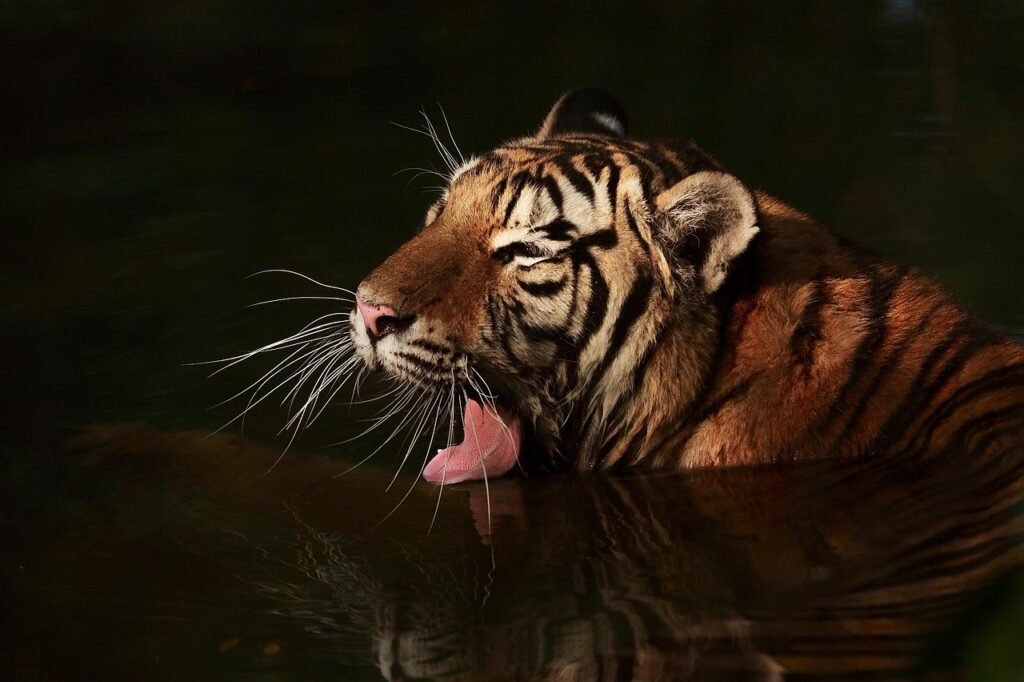Tigers, the largest of the big cats, are an undeniable symbol of power and grace. One intriguing aspect of their behavior is their affinity for water, a trait not commonly shared with other big cats like lions, leopards, and cheetahs. Understanding why tigers love water requires exploring their evolutionary history, environmental adaptations, and the survival benefits tied to this unusual habit.
Evolutionary Roots of Tigers’ Water Affinity

The tigers’ love for water may trace back to their evolutionary past. Originally believed to have evolved in Siberia, where waterways played a crucial role in the landscape, tigers might have adapted to swimming as part of their migratory and hunting practices. Unlike most of their feline relatives, these cats used water bodies not as barriers but as pathways, which became ingrained in their natural behaviors over time.
Geographical Distribution and Habitat Preferences

Tigers inhabit various landscapes across Asia, often found in regions with abundant water sources such as rivers, lakes, and swamps. Regions like the Sundarbans in India and Bangladesh, which are characterized by vast mangrove forests and complex riverine systems, provide prime examples of how water-rich environments shape a tiger’s way of life. In these environments, water becomes an integral part of survival and daily habits.
Survival and Hunting Benefits

Swimming prowess can offer several survival advantages. For tigers, water bodies serve as strategic allies for hunting. Unlike other big cats, tigers use water to stalk and ambush unsuspecting prey. Their ability to swim silently allows them to catch animals off guard, giving them a surprising edge over their quarry. This natural stealth tactic is a key reason why they continue to prefer water-rich environments.
Thermoregulation and Cooling Mechanisms

In the hot, often humid environments they inhabit, tigers utilize water as a cooling mechanism. Taking a dip in nearby streams or lakes helps regulate their body temperature during sweltering days. This behavior is vital for their well-being in tropical climates, and it provides relaxation and a reprieve from the heat.
Social Behavior and Play

Tigers are typically solitary animals, but their interactions with water reveal a more playful side. Observations show that even captive tigers engage in play around water. Whether chasing after fish, splashing, or engaging in mock battles, such activities highlight how water can be a source of enrichment and mental stimulation for these majestic creatures.
Adaptations That Support Swimming

The swimming ability of tigers also owes to their physical adaptations. Strong, muscular limbs, retractable claws, and webbing between their toes make them excellent swimmers. These physical traits allow them to paddle efficiently, maintain speed, and navigate through the water with ease.
Comparison with Other Big Cats

Unlike tigers, other big cats like lions and leopards largely avoid water. Lions, primarily found in the arid savannas of Africa, have less interaction with water, while leopards exhibit a more ambivalent relationship, often avoiding water unless necessary. This stark contrast raises questions about the specific ecological and behavioral needs that set tigers apart from their feline cousins.
Cultural and Mythological Significance of Tigers and Water

The relationship between tigers and water is also reflected in various cultural myths and folklore, particularly in Asia. Throughout history, tigers have been associated with rivers and large water bodies, often depicted as guardians or mythical creatures with dominion over water. Such narratives underscore the deep connection between the animal and its environment.
Protection and Conservation Issues

Today, tiger populations face significant threats due to habitat destruction, poaching, and environmental changes. Preserving their natural habitats, particularly those with rich water resources, is crucial for their survival. Conservation efforts aimed at protecting water habitats ensure these magnificent creatures continue to thrive in the wild.
Conclusion: Embracing the Water-Loving Nature of Tigers

Tigers’ love for water distinguishes them from their feline relatives, encapsulating a blend of evolution, adaptation, and survival strategies. Understanding their unique relationship with water not only enriches our knowledge of these majestic cats but also highlights the importance of conserving their natural habitats. As our fascination with tigers endures, safeguarding their watery domains remains vital for their continued existence in the wild.
Hi, I’m Bola, a passionate writer and creative strategist with a knack for crafting compelling content that educates, inspires, and connects. Over the years, I’ve honed my skills across various writing fields, including content creation, copywriting, online course development, and video scriptwriting.
When I’m not at my desk, you’ll find me exploring new ideas, reading books, or brainstorming creative ways to solve challenges. I believe that words have the power to transform, and I’m here to help you leverage that power for success.
Thanks for stopping by, Keep coming to this website to checkout new articles form me. You’d always love it!






